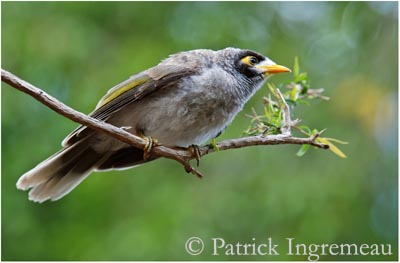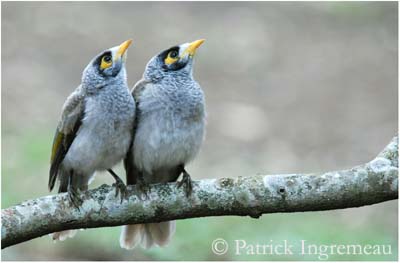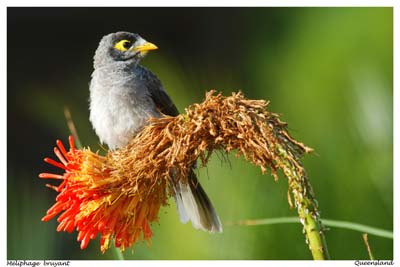
Noisy Miner
Manorina melanocephala
Passeriforme Order – Meliphagidae Family
BIOMETRICS :
Length : 25-29 cm
Weight : 60 g
DESCRIPTION:
Noisy Miner is an aggressive bird, living in groups or colonies.
Adult male has pale grey plumage overall, with darker wings and tail. Wings are slightly washed green on the edges. Mantel is pale grey scaled with dark grey.
Underparts are paler, whitish-grey on belly, vent and undertail feathers. Chin, throat and breast are whitish-grey, spotted with darker grey.
Head shows black crown and cheeks. Forehead, face and nape are brownish-grey, spotted with darker grey, as mantel.
Pointed, conical bill is yellow. Eyes are dark brown, with yellow patch of bare skin behind each eye. Legs and feet are yellow.
Both sexes are similar.
DIET:
Noisy Miner feeds on insects, nectar and fruits. It may occasionally feed small reptiles and amphibians.
PROTECTION / THREATS / STATUS:
Noisy Miner is common in its range. It is sometimes considered as pest, due to its noisy displays and incessant calls. Numbers are increasing, as a result of clearing endemic vegetation for agriculture and grazing. Noisy Miners expand their range, excluding other insectivorous bird species from their areas.
Fr: Méliphage bruyant
All : Weißstirn-Schwatzvogel
Esp : Manorina Alborotadiza
Ital : Minatore chiassoso
Nd : Tuinhoningeter
Photographs by Patrick Ingremeau
His website : TAMANDUA
Text by Nicole Bouglouan
Sources:
Birds in backyards (Birds Australia and Australian Museum)
Wikipedia (Wikipedia, The Free Encyclopedia)
Welcome to the Australian Museum

VOICE: SOUNDS BY XENO-CANTO
Noisy Miner utters loud “pwee-pwee-pwee” and a piping “pee-pee-pee” if disturbed or threatened. All members of the colony repeat these calls if alarmed. These warning calls gave its name to the species.
Various other calls include clicks, peeps and squeaks.
HABITAT:
Noisy Miner is now well adapted to developed areas, and it is common in urban parks and gardens.
But it also lives in rural areas such as woodlands, open forests, scrubs and grasslands where it forages for food.
RANGE:
Noisy Miner lives in eastern and southern parts of Australia, and it is also found in Tasmania.
BEHAVIOUR:
Noisy Miner often feeds in groups, in trees or on ground. Its diet is varied, from insects to fruits, nectar and small reptiles.
Noisy Miner lives in groups from 4 to 12 birds or more important colonies. All members are aggressive and territorial, defending actively their area against intruders and predators. They can harass and chase away larger birds such as corvids. The group often chases away all other species from its territory. Birds give their alarm calls in order to alert the whole colony.

Noisy Miner male performs some displays such as flights and facial displays. In this species, the eye patch can vary, providing an enlargement of the dark eyes, very important in intimidation displays. Most of displays are used as advertising for nesting colony location.
Male and female may perform duets, by special vocalisations.
Bond maintenance in the colony is very important, and maintained by several displays and communal activities.
FLIGHT:
Noisy Miner performs flight displays during breeding season. It likes clear spaces for flying and gliding easily in the air.
REPRODUCTION:
Breeding season occurs from July to December. Noisy Miner breeds communally. Groups include several males and females, and young of previous broods.
There are about three males for one female. Males perform most part of helping and members share the rearing of nestlings.
Nest is situated in fork in tree or shrub. Female builds the cup-shaped nest with twigs and grasses. This species prefers nesting areas surrounded by short grasses spaces, because young often tend to fall out of the nest too soon after hatching, and this kind of habitat allows adults better view of predators. Usually, young birds once on ground spend the time in a bush or low branch, while some family member surveys the approaching intruders.
Female lays and incubate her eggs alone. Both sexes care and feed the young, and helpers share these duties with parents.
This species may produce several broods per season.
